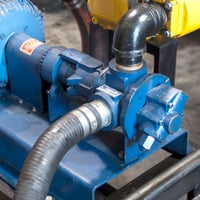If you've decided on a positive displacement pump but aren't sure which type suits you best, it's...
Restarting Pumps After Shutdown: Your Essential Checklist
 Shutdowns for unexpected issues or even planned maintenance can be brutal to your operations. Even worse, if the shutdown is for an unplanned length of time, it’s likely that you need to inspect your pumping equipment to make sure everything is up and running immediately. Before you dive back into the grind, Professional Pump can help get your pumps back into action.
Shutdowns for unexpected issues or even planned maintenance can be brutal to your operations. Even worse, if the shutdown is for an unplanned length of time, it’s likely that you need to inspect your pumping equipment to make sure everything is up and running immediately. Before you dive back into the grind, Professional Pump can help get your pumps back into action.
Shutdowns for unexpected issues or even planned maintenance can be brutal to your operations. Even worse, if the shutdown is for an unplanned length of time, it’s likely that you need to inspect your pumping equipment to make sure everything is up and running immediately. Before you dive back into the grind, let’s ensure your pumps are ready for action.
Inventory Check: Are You Stocked Up?
First things first—check your parts inventory. Do you have common replacement parts for your pumps? As maintenance teams prep pumps for restart, they may discover parts needing replacement, or worse, experience a pump failure during start-up. Make sure you have enough parts on hand for inspections and repairs. If you need help auditing your equipment and building parts lists for your next shutdown, we’re here to help.
Positive Displacement and Centrifugal Pumps
Long shutdowns mean your pumping equipment needs some TLC to keep fluid transfers smooth. Here’s your quick-start guide for a hassle-free reboot:
Check Pump Rotation Lock out the pump and remove the coupling guard. Turn the shaft by hand—listen for any odd sounds. If it doesn’t turn, don’t force it; disassemble and investigate.
Inspect the Coupling While the guard is off, inspect the coupling for wear. Look for rubber, dust or plastic debris, which indicates misalignment. Realign the pump before restarting.
Examine the Mechanical Seal Check for leaks and ensure flush water is flowing to the mechanical seal.
Oil and Lubrication Levels Verify that all pumps and drivers are properly lubricated according to their IOM (Installation, Operation, and Maintenance) manuals.
Valves Set for Start-Up Ensure suction valves are open and liquid is in the pump, while discharge valves should be 10-15% open.
Prime and Vent the Pump With the suction valve open, the pump should fill and prime.
Base Inspection Tighten mounting bolts and check for soft feet on the pump or motor. Baseplate pads should be level within .002” per foot, with a max deviation of 1/32” from one end to the other.
Final Check Before Start-Up Once you start the pumps, monitor for smooth operation—no unusual noises, vibrations, or overheating bearings.
Air-Operated Diaphragm Pumps
Don’t forget about air-operated diaphragm pumps! Here’s what to check:
- Blow Out Air Lines: Remove condensation that could lead to rust and debris entering the air and pilot valves.
- Change Inline Filter Element: If it’s been a while, replace filters to maintain required PSI and SCFM.
- Ensure Pump is Primed: Running these pumps dry is a no-go; it’ll ruin the diaphragms.
- Open Discharge Valve: Essential for proper operation.
- Flush the Pump: Solid buildup can cause damage. If flushing isn’t feasible, start the pump at low pressure to agitate the contents—but avoid using pressurized water or steam.
- Check Your Stock: Have essential parts on standby to minimize downtime in case of failure.
Taking these steps will ensure success after shutdowns: if you take the time to prep your pumping equipment to make sure it’s ready for action.
Need assistance getting those pumps back online? We're here to help! We offer shutdown support and start-up services across Michigan and Northwest Ohio.




